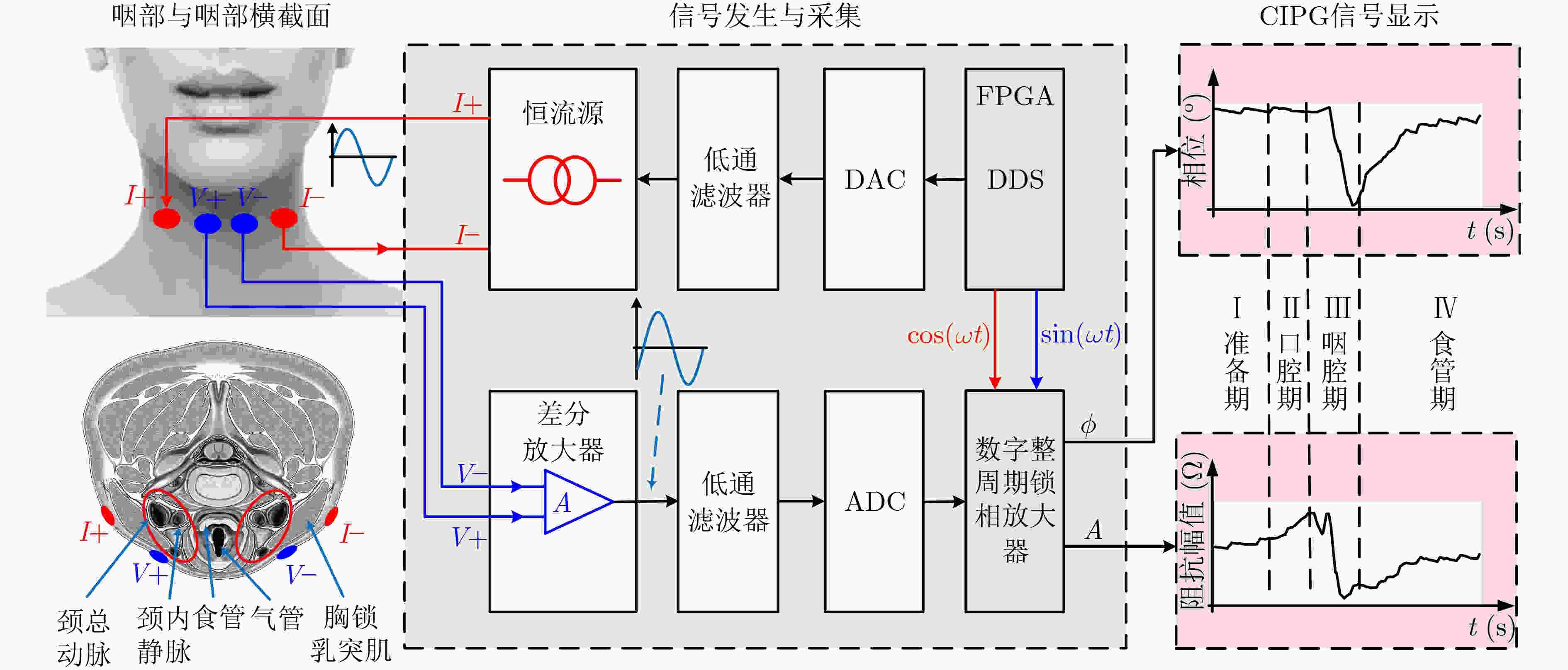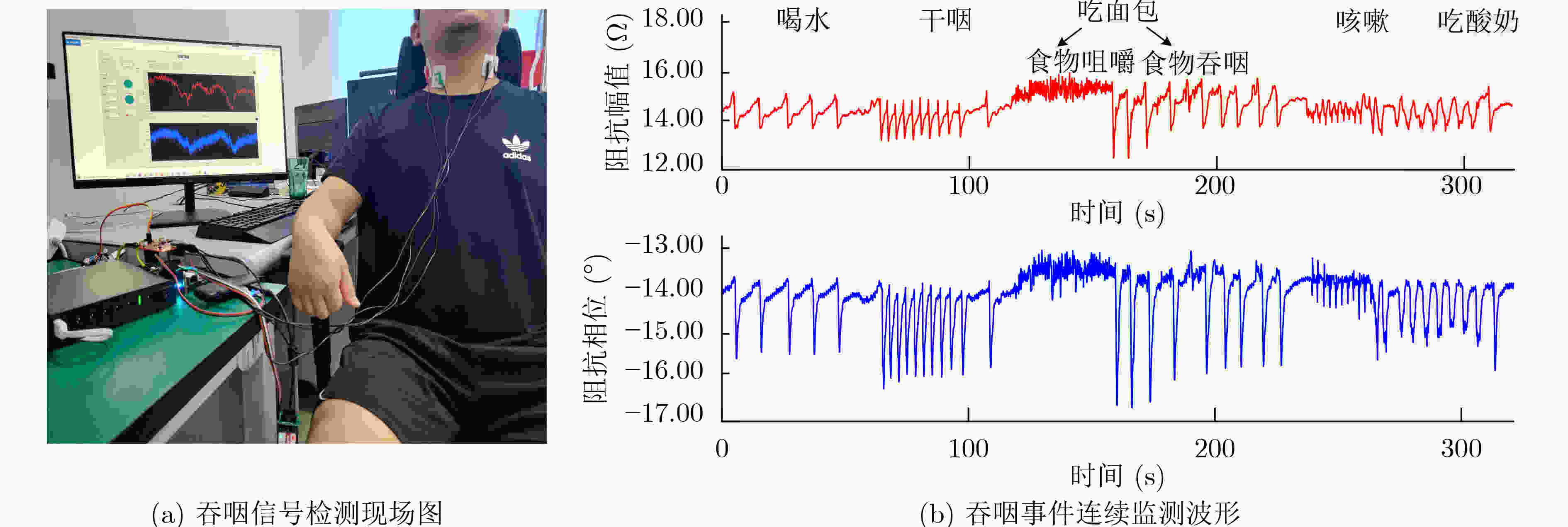Detection and Intelligent Recognition Method of Swallowing Events Based on Complex Impedance Pharyngography
-
摘要: 吞咽障碍早期筛查是降低吞咽障碍发病率的重要手段,而对吞咽事件(SE)的准确识别是吞咽障碍筛查和治疗过程中的关键环节。阻抗咽造影(IPG)是一种新型非侵入式吞咽事件检测方法,但现有的IPG技术仅检测阻抗幅值而忽略了同样重要的相位信息。为了实现对吞咽事件的全面检测及智能识别,该文提出一种基于整周期数字锁相放大原理的复阻抗咽造影(CIPG)检测方法,设计了基于FPGA的CIPG检测系统以连续描记吞咽过程的复阻抗(阻抗幅值和相位)信息,并设计了基于连续小波变换(CWT)和GoogLeNet相结合的吞咽事件智能识别算法。设计了包含喝水、干咽、吃面包、吃酸奶、咳嗽等5种吞咽事件的识别实验,实验结果表明,仅利用阻抗幅值信息时的吞咽事件识别准确率为86.1%,而同时利用阻抗幅值和相位信息时的识别准确率为95.7%,后者的识别准确率高于其它算法。该研究证实了CIPG技术和吞咽事件智能识别算法的有效性与优越性,为下一步开发基于CIPG的吞咽障碍早期筛查方法奠定了理论和技术基础。Abstract: Early screening of dysphagia is an important means to reduce the incidence of dysphagia, and accurate identification of Swallowing Events (SE) is a key step in the screening and treatment of dysphagia. Impedance PharyngoGraphy (IPG) is a new non-invasive SE detection method, but the existing IPG technique only detects the impedance amplitude and ignores the equally important phase information. Aiming to comprehensively extracting and intelligently recognizing SE, a Complex Impedance PharyngoGraphy (CIPG) detection method based on integer-period digital lock-in amplifying principle is proposed, and a CIPG measurement system is designed based on FPGA to continuously record the complex impedance (amplitude and phase) information during swallowing process, and an SE intelligent recognition algorithm based on Continuous Wavelet Transform (CWT) and GoogLeNet is designed. A five-SE recognition experiment including drinking water, dry swallowing, eating bread, eating yogurt and coughing is designed. The experimental results show that the SE recognition accuracy is 86.1% when only using impedance amplitude information, and 95.7% when using both impedance amplitude and phase information. The latter SE recognition accuracy is higher than that of other algorithms. This study confirms the effectiveness and superiority of CIPG technology and SE intelligent recognition algorithm, and lays a theoretical and technical foundation for further developing an early screening method of dysphagia based on CIPG.
-
表 1 吞咽事件识别对比实验结果(%)
评价标准 基于幅值信息的识别 基于幅值+相位信息的识别 精确率P 召回率R F1 精确率P 召回率R F1 干咽 82.0 87.4 84.6 93.7 96.6 95.1 喝水 90.0 92.3 91.1 94.7 92.3 93.4 吃面包 85.0 97.1 90.6 97.1 97.1 97.1 吃酸奶 87.0 62.5 72.7 96.9 96.9 96.9 咳嗽 91.3 95.5 93.3 100.0 95.5 97.6 -
[1] JAYATILAKE D, UENO T, TERAMOTO Y, et al. Smartphone-based real-time assessment of swallowing ability from the swallowing sound[J]. IEEE Journal of Translational Engineering in Health and Medicine, 2015, 3: 1–10. doi: 10.1109/JTEHM.2015.2500562 [2] TOBIN A B, MIHNEA M, HILDENBRAND M, et al. Bolus rheology and ease of swallowing of particulated semi-solid foods as evaluated by an elderly panel[J]. Food & Function, 2020, 11(10): 8648–8658. doi: 10.1039/D0FO01728K [3] POWERS W J, RABINSTEIN A A, ACKERSON T, et al. 2018 guidelines for the early management of patients with acute ischemic stroke: A guideline for healthcare professionals from the American Heart Association/American Stroke Association[J]. Stroke, 2018, 49(3): e46–e99. doi: 10.1161/STR.0000000000000158 [4] TEUSCHL Y, TRAPL M, RATAJCZAK P, et al. Systematic dysphagia screening and dietary modifications to reduce stroke-associated pneumonia rates in a stroke-unit[J]. Plos One, 2018, 13(2): e0192142. doi: 10.1371/journal.pone.0192142 [5] 中国吞咽障碍康复评估与治疗专家共识组. 中国吞咽障碍评估与治疗专家共识(2017年版)第二部分 治疗与康复管理篇[J]. 中华物理医学与康复杂志, 2018, 40(1): 1–10. doi: 10.3760/cma.j.issn.0254-1424.2018.01.001Chinese Expert Consensus Group on the Evaluation and Treatment of Dysphagia Rehabilitation. Expert consensus on evaluation and treatment of dysphagia in China (2017 Edition)[J]. Chinese Journal of Physical Medicine and Rehabilitation, 2018, 40(1): 1–10. doi: 10.3760/cma.j.issn.0254-1424.2018.01.001 [6] SHIMAZAKI Y, SAITO M, NONOYAMA T, et al. Oral factors associated with swallowing function in independent elders[J]. Oral Health & Preventive Dentistry, 2020, 18(1): 683–691. doi: 10.3290/j.ohpd.a45071 [7] PAVITHRAN J, PUTHIYOTTIL I V, KUMAR M, et al. Exploring the utility of fibreoptic endoscopic evaluation of swallowing in young children-a comparison with videofluoroscopy[J]. International Journal of Pediatric Otorhinolaryngology, 2020, 138: 110339. doi: 10.1016/j.ijporl.2020.110339 [8] KU P K M, HOLSINGER F C, CHAN J Y K, et al. Management of dysphagia in the patient with head and neck cancer during COVID‐19 pandemic: practical strategy[J]. Head & Neck, 2020, 42(7): 1491–1496. doi: 10.1002/hed.26224 [9] O'BRIEN M K, BOTONIS O K, LARKIN E, et al. Advanced machine learning tools to monitor biomarkers of dysphagia: A wearable sensor proof-of-concept study[J]. Digital Biomarkers, 2021, 5(2): 167–175. doi: 10.1159/000517144 [10] KUROSU A, COYLE J L, DUDIK J M, et al. Detection of swallow kinematic events from acoustic high-resolution cervical auscultation signals in patients with stroke[J]. Archives of Physical Medicine and Rehabilitation, 2019, 100(3): 501–508. doi: 10.1016/j.apmr.2018.05.038 [11] KHALIFA Y, COYLE J, and LSEJDIĆ E. Non-invasive identification of swallows via deep learning in high resolution cervical auscultation recordings[J]. Scientific Reports, 2020, 10(1): 8704. doi: 10.1038/s41598-020-65492-1 [12] SCHULTHEISS C, SCHAUER T, NAHRSTAEDT H, et al. Automated detection and evaluation of swallowing using a combined EMG/bioimpedance measurement system[J]. The Scientific World Journal, 2014, 2014: 405471. doi: 10.1155/2014/405471 [13] SUZUKI M, SASAKI M, KAMATA K, et al. Swallowing pattern classification method using multichannel surface EMG signals of suprahyoid and infrahyoid muscles[J]. Advanced Biomedical Engineering, 2020, 9: 10–20. doi: 10.14326/abe.9.10 [14] DAMOURAS S, SEJDIC E, STEELE C M, et al. An online swallow detection algorithm based on the quadratic variation of dual-axis accelerometry[J]. IEEE Transactions on Signal Processing, 2010, 58(6): 3352–3359. doi: 10.1109/TSP.2010.2043972 [15] FAROOQ M, FONTANA J M, and SAZONOV E. A novel approach for food intake detection using electroglottography[J]. Physiological Measurement, 2014, 35(5): 739–751. doi: 10.1088/0967-3334/35/5/739 [16] KALANTARIAN H, ALSHURAFA N, and SARRAFZADEH M. A wearable nutrition monitoring system[C]. 2014 11th International Conference on Wearable and Implantable Body Sensor Networks, Zurich, Switzerland, 2014: 75–80. [17] MIRTCHOUK M, MERCK C, and KLEINBERG S. Automated estimation of food type and amount consumed from body-worn audio and motion sensors[C]. The 2016 ACM International Joint Conference on Pervasive and Ubiquitous Computing, Heidelberg, Germany, 2016: 451–462. [18] BI Yin, LV Mingsong, SONG Chen, et al. AutoDietary: A wearable acoustic sensor system for food intake recognition in daily life[J]. IEEE Sensors Journal, 2016, 16(3): 806–816. doi: 10.1109/JSEN.2015.2469095 [19] INOUE K, YOSHIOKA M, YAGI N, et al. Using machine learning and a combination of respiratory flow, laryngeal motion, and swallowing sounds to classify safe and unsafe swallowing[J]. IEEE Transactions on Biomedical Engineering, 2018, 65(11): 2529–2541. doi: 10.1109/TBME.2018.2807487 [20] KUSUHARA T, NAKAMURA T, SHIRAKAWA Y, et al. Impedance pharyngography to assess swallowing function[J]. Journal of International Medical Research, 2004, 32(6): 608–616. doi: 10.1177/147323000403200605 [21] ZHANG Fu, MCILDUFF C, GUTIERREZ H, et al. Bioimpedance Measurement to Evaluate Swallowing in a Patient with Amyotrophic Lateral Sclerosis[C]. International Conference on Electrical Bioimpedance, Joinville, Brazil, 2019: 107–112. [22] RENGARAJAN A and GYAWALI C P. Functional anatomy and physiology of swallowing and esophageal motility[M]. RICHTER J E, CASTELL D O, KATZKA D A, et al. The Esophagus. 6th ed. Chichester: John Wiley & Sons Ltd. , 2021: 59–96. [23] ALIX J J P, MCDONOUGH H E, SONBAS B, et al. Multi-dimensional electrical impedance myography of the tongue as a potential biomarker for amyotrophic lateral sclerosis[J]. Clinical Neurophysiology, 2020, 131(4): 799–808. doi: 10.1016/j.clinph.2019.12.418 [24] SANCHEZ B, IYER S R, LI Jia, et al. Non‐invasive assessment of muscle injury in healthy and dystrophic animals with electrical impedance myography[J]. Muscle & Nerve, 2017, 56(6): E85–E94. doi: 10.1002/mus.25559 [25] 李刚, 周梅, 何峰, 等. 基于数字锁相相关计算结构的优化算法[J]. 电子与信息学报, 2012, 34(3): 744–748. doi: 10.3724/SP.J.1146.2011.00333LI Gang, ZHOU Mei, HE Feng, et al. An optimization algorithm based on computation structure of correlation in digital lock-in detection[J]. Journal of Electronics &Information Technology, 2012, 34(3): 744–748. doi: 10.3724/SP.J.1146.2011.00333 [26] CHEN Xinda, WEI Minxiang, CHEN Kai, et al. Research on weak signal detection of integral average digital lock-in amplifier[J]. Measurement Science and Technology, 2021, 32(10): 105905. doi: 10.1088/1361-6501/ac0d74 [27] GRIMNES S and MARTINSEN Ø G. Sources of error in tetrapolar impedance measurements on biomaterials and other ionic conductors[J]. Journal of Physics D:Applied Physics, 2006, 40(1): 9–14. doi: 10.1088/0022-3727/40/1/S02 [28] 杨淑莹, 桂彬彬, 陈胜勇. 基于小波分解和1D-GoogLeNet的心律失常检测[J]. 电子与信息学报, 2021, 43(10): 3018–3027. doi: 10.11999/JEIT200774YANG Shuying, GUI Binbin, and CHEN Shengyong. Arrhythmia detection based on wavelet decomposition and 1D-GoogLeNet[J]. Journal of Electronics &Information Technology, 2021, 43(10): 3018–3027. doi: 10.11999/JEIT200774 [29] ALSHURAFA N, KALANTARIAN H, POURHOMAYOUN M, et al. Recognition of nutrition intake using time-frequency decomposition in a wearable necklace using a piezoelectric sensor[J]. IEEE Sensors Journal, 2015, 15(7): 3909–3916. doi: 10.1109/JSEN.2015.2402652 [30] SAZONOV E S, MAKEYEV O, SCHUCKERS S, et al. Automatic detection of swallowing events by acoustical means for applications of monitoring of ingestive behavior[J]. IEEE Transactions on Biomedical Engineering, 2010, 57(3): 626–633. doi: 10.1109/TBME.2009.2033037 -






 下载:
下载:







 下载:
下载:
